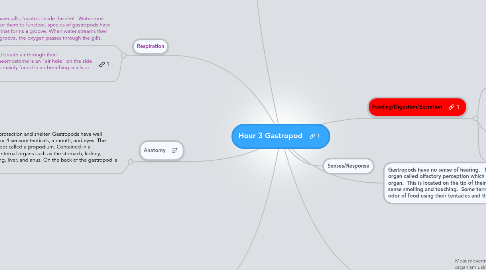Hour 3 Gastropod
by Karla Lockman


1. Anatomy
1.1. All gastropods have a shell for protection and shelter. Gastropods have well defined head that consists of 2 or 4 sensory tenticals, a mouth, and eyes. The gastropod moves with a small foot called a propodium. Contained in a Gastropod's shell are all of the internal organs such as the stomach, kidney, mantle, heart, vast deferens, lung, liver, and anus. On the back of the gastropod is the respiratory pore.
2. Respiration
2.1. Some gastropods have gills, located inside the shell. Water must pass over the gills for them to function. species of gastropods have a mantle overhang that forms a groove. When water streams flow through the pallial groove, the oxygen passes through the gills.
2.1.1. http://www.asnailsodyssey.com/IMAGES/CHITON/Petersen&Johansen1973Fig1.gif
2.2. Gastropods (on land) breath air through their pheomostome. A pheomostome is an "air hole" on the side of the mantle. This is mainly found in air breathing snails or slugs.
3. Reproduction/Life Cycle
3.1. Most of the Gastropods Reproduce asexually , but some can mate with other Gastropods as well. They both have the female and male sexual organs. Also they will reproduce and have eggs , they release them into the water or on land and they hatch and free float and they grow to become adults.
4. Circulation
4.1. Gastropods have mainly open circulatory systems. They may have blood vessels or veins, but the blood does not circulate entirely within vessels. Blood is collected from the gills, pumped through the heart, and released directly into the tissue from which it returns to the gills and then to the heart.
5. Gastropods have no sense of hearing. Most Gastropods have a sensory organ called olfactory perception which is the most important sensory organ. This is located on the tip of their of their tentacles, is used to sense smelling and touching. Some terrestrial gastropods can track the odor of food using their tentacles and the wind.
6. Movement
6.1. Most movenment happens by the organism using it's foot to move across surfaces.
6.2. Some gastropods move by contracting their muscles and have a slime layer they leave behind that makes it easy for the organism to slide across surfaces.
7. Feeding/Digestion/Excretion
7.1. Digestion:Gastropods digest their foods in a few ways.
7.1.1. Gizzards are used to grind food
7.1.2. Crops are used to store food
7.1.3. A vestibule sorts out large food pieces.
